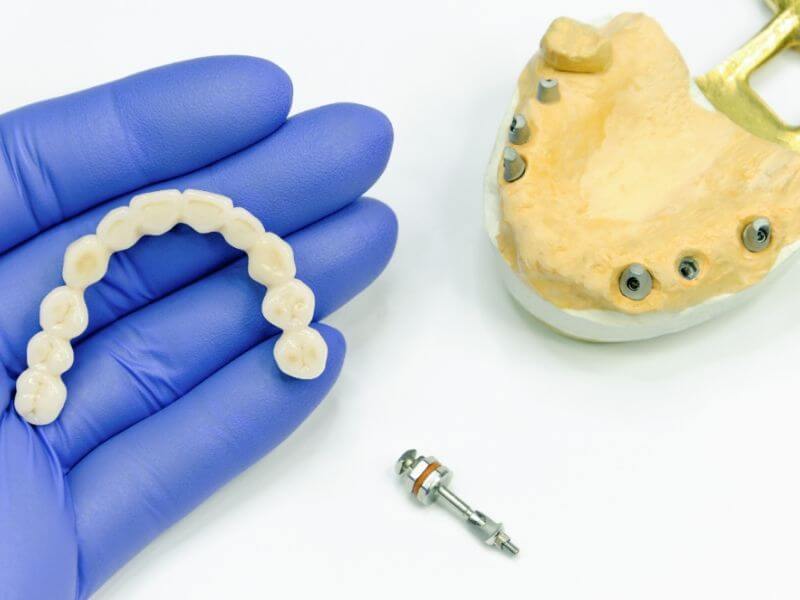A dental bridge is a fixed appliance that helps replace missing teeth. Typically, dental bridges can last for decades without ever needing attention. However, bridges can become loose or damaged, decay can get under the bridge and damage surrounding teeth, or changes in your teeth alignment can affect how the bridge fits in your mouth. When these things occur, bridge removal may be necessary. But can a dental bridge be removed and recemented into place? It all depends on the integrity of the bridge and the underlying problems. Here, Soundview Family Dental explains what a dental bridge is, and the complications that can lead to removal and replacement.
Key Takeaways
- Dental bridges replace missing teeth and can last for years but may need removal if they become loose, damaged, or decayed.
- Removal and recementation of dental bridges depend on their condition and underlying issues.
- Complications of dental bridges include poor fit, damage to neighboring teeth, increased gum disease risk, and fractures.
- Factors like poor oral hygiene, lack of dental care, bad habits, and weak abutment support can cause dental bridge failure.

What is a dental bridge?
When you lose a tooth due to decay or other complications, the empty space affects the nearby teeth. With an open space, nearby teeth can tilt or drift out of place, affecting your bite and causing pain or tooth damage. A dental bridge is an appliance that replaces the empty space. A dental bridge consists of two or more crowns that fit on the top of the anchoring teeth or abutment. Between these crowns is a pontic, or false tooth, which will fill the gap of your missing tooth. The dentist cements the crowns into place over the healthy surrounding teeth. A dental bridge both restores the functionality of your teeth, and also provides significant cosmetic benefits by replacing a lost tooth and giving you back your smile.
Possible risks and complications associated with dental bridges
As many as 120 million people in the United States are missing at least one tooth. This makes dental bridges a quite common and necessary dental appliance. While bridges are a highly successful dental treatment option, there is always a risk of possible complications that can require the removal or replacement of a bridge. These can include:
- An improper or ill-fitting bridge – a poor or loose fit can lead to the build-up of tooth decay on the healthy teeth that are under the crowns. Because the dentist must file down the healthy teeth in order to place the crown, these teeth are more susceptible to decay. This decay to the anchoring teeth can lead to tooth damage and bridge instability.
- Damage to neighboring teeth – Over time, dental bridges can develop rough areas. If these rough areas come in contact with other teeth, they can wear down natural tooth enamel on healthy teeth.
- Increased risk of gum disease – Dental appliances, such as a dental bridge, can increase a person’s risk of gum disease. Regular brushing can help reduce this risk, as can regular dental cleanings. Regular dental visits allow your dentist to catch any potential signs of gum disease early and nip it in the bud before it causes any lasting damage.
- Fractures to the pontic or crowns – While pontics and crowns are made to handle the force of chewing, they can still be fragile. Eating hard foods, such as hard candy, can crack or fracture the surface, create a chip, or completely damage the bridge. While small chips and cracks can often be repaired, larger breaks can require a new bridge.
Causes of dental bridge failures
While dental bridges are designed to last for many years, many things can contribute to the failure of a dental bridge. When this happens, your dentist may need to remove, repair, or replace your dental bridge. Some common causes of bridge failure include:
- Poor Oral Hygiene – The number one cause of bridge failure is poor oral hygiene. The build-up of decay around and under the crown can cause damage to the stabilizing teeth, resulting in bridge failure.
- Poor Abutment Support – Changes to supporting teeth can reduce the stability of a dental bridge. Instability or reduced support from these teeth can result in uneven distribution of pressure on the bridge and can result in failure.
- Bad Habits – Do you tend to chew on a pen when stressed? Do you suffer from nighttime teeth grinding? Are nuts and hard candies your favorite? Any of these habits can cause damage to the crowns or pontic of your bridge.
- Lack of Regular Dental Care – While good oral hygiene at home is essential to maintain the life of your bridge, so are regular visits to your dentist. Regular oral exams can catch any potential problems with your bridge before they lead to bridge failure.

Can a bridge be recemented after removal?
How a dentist removes a damaged bridge depends on a variety of different factors. Loose bridges can often be easily removed and repaired, allowing your dentist to recement the bridge into place. However, the cement used to bond a bridge in place is designed to last for many years and it is not always possible to remove a bridge without causing damage to the support of surrounding teeth. Your dentist can try to tap off the bridge, but this can often injure and even fracture the support teeth. In these cases, the dentist will need to drill off the bridge and create a new one. What your dentist chooses to do will depend on the cause of the bridge failure, how strong the current bridge bond is, the integrity of the supporting teeth, and the desired result.
Consult your dentist for recommendations and treatments
As you can see, dental bridges provide both a structural and cosmetic solution for missing teeth. But they also require care and often change of habits. If you have missing teeth, or if you currently have a dental bridge that is causing you concern, contact Soundview Family Dental today to see how we can help. It may be possible to repair an existing bridge while in place or with careful removal, or it may be time for a new bridge.


